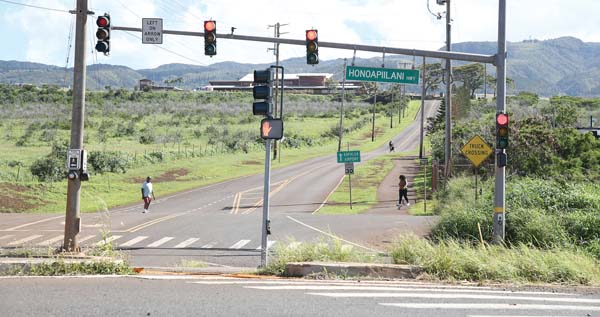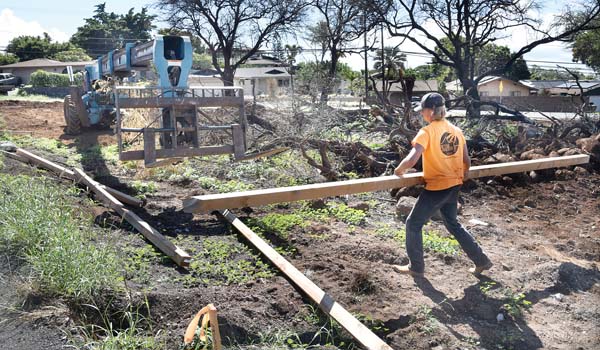‘Priority projects’ aim to reach 5,000-unit goal
Fully affordable projects in the pipeline, though funding, pandemic create some delays

Akahele Street bisects the Pulelehua development on its way to Kapalua Airport Tuesday afternoon. The future 800-unit affordable housing development in West Maui will consist of 100 affordable for-sale units, 400 market-rate units and 300 workforce rentals, and 100 single-family lots with the potential for 100 additional ohana units. The Maui News / MATTHEW THAYER photos
The Maui County Council is hoping a series of housing projects in the works will help the county reach its goal of building 5,000 affordable for-rent and for-sale units over the next five years.
Thirty-six “priority projects” outlined in the Maui County Comprehensive Affordable Housing Plan are projected to provide an estimated combined total of 4,311 income-restricted rental and ownership units.
Council Member Gabe Johnson, chairperson of the Affordable Housing Committee that heard status updates on the projects earlier this week, said Tuesday that “the numbers of units in the pipeline is encouraging,” but the council still needs to spend more time taking a closer look at the actual price of the units and which income brackets they serve.
Johnson said that the plan helped the council to understand that 35 percent of the units built need to be for residents in the 50 to 80 percent area median income category, which is an annual salary of $47,950 to $76,720 per year, and 50 percent of the units built need to be for those making under $47,950 per year.
“That’s a big reason I introduced legislation that would require affordable developments to target the income brackets where we have identified the greatest need and to reexamine the formula that defines what folks in each income bracket can afford,” he told The Maui News.

Betsil Brothers laborer John Cavness loads four-by-four dust fencing posts onto a boom lift Tuesday afternoon at the Hale Kaiola project in North Kihei. The project is currently taking applications for 40 two- and three-bedroom units in 20 duplex buildings. It’s considered one of the 36 “priority projects” in Maui County’s affordable housing plan that aims to bring about 5,000 units online in the next five years.
Making up nearly a quarter of the county’s projected goal, the Waikapu Country Town project is on track to develop 1,433 single-family, multifamily and rural units, as well as 146 ohana units and a 12-acre elementary school.
Like Waikapu Country Town, many projects heard during the meeting on Monday are anticipated to be done before or by 2024.
Though progress is steady, one of the “biggest issues” with Waikapu Country Town is the timing of when the affordable units will be built in relation to when the market-rate units will be sold, said Jeff Ueoka, an attorney with the project.
“They understand the need for the affordables to be done first, but just money-wise for infrastructure improvements and all the other things that need to go in before the affordables can go in, that all costs money and sometimes the market-rate buyers and developers help us out with that,” Ueoka said.
Nonetheless, housing developer Mike Atherton said the conceptual maps are almost ready and they are currently working on wastewater plans and the Waiale Road extension.
Another large development that could help chip away at the county’s goal is Pulelehua, an 800-unit affordable housing development in West Maui that received approvals in October to move forward and begin construction next year. The breakdown consists of 100 affordable for-sale units, 400 market-rate units and 300 workforce rentals, and 100 single-family lots with the potential for 100 additional ohana units.
Multiple projects on the horizon consist solely of affordable units. Alaula Builders LLC, for example, is developing three 100-percent affordable for-sale neighborhoods, including Hale Kaiola, which is currently taking applications for 40 two- and three-bedroom units in 20 duplex buildings in North Kihei; and Hale Waipuilani, which will have 28 for-sale workforce homes in Kihei, with families slated to begin moving in by 2024.
An environmental assessment will be submitted for Kuikahi Village, which would consist of 202 mixed-used for-sale homes in a workforce neighborhood below Wailuku Heights, said Lawrence Carnicelli, vice president of development for Alaula Builders.
Liloa Hale, a 100 percent senior affordable housing project managed by Hale Mahaolu, is just waiting on final arrangements for state funding and permitting as construction is slated for 2023, said Executive Director Grant Chun. The 3.61-acre property in Kihei will have a three-story apartment building with 117 units, which will be available for rent to those 55 years old and up earning 60 percent or below the area median income.
Another 100-percent affordable project, Hale O Pi’ikea, is in the preliminary stages of constructing 90 rental units between two four-story buildings in Kihei. There will also be a community center, exercise room and open green space.
Phase 1 of the $54-million project should be completed and leased by July 2024, according to the Hawaiian Community Development Board. Phase 2 and 3 of the project consist of 97 affordable units for kupuna and 36 affordable townhomes, respectively. The second two phases will take place concurrently after finishing phase 1.
Each portion of the project will have one- , two- , and three-bedroom units available at 30 to 60 percent of the area median income.
Some housing projects have faced financial issues due to the pandemic or funding sources falling through.
Developers of the $85 million Hale Pilina, for example, plan to seek about $43 million in funding for phase 1 in February after the Hawaii Housing Finance and Development Corporation “was unable to provide as much funding as they would have liked” last year, said Kari Luna Nunokawa, senior manager for project consultant Munekiyo Hiraga.
The affordable rental housing project proposed for development next to the Kahului Post Office, would include 178 units — 108 one-bedroom units and 70 two-bedroom units for rent for those who earn 60 percent or less of the area median income. It would be built in two phases, with each phase expected to take 16 to 18 months to construct.
Linda Schatz of Schatz Collaborative said that the COVID-19 pandemic created financial difficulties for the 324-unit Wailuku Apartments project, but that developers finally secured an “interested investor” in October and are hopeful to begin mass grading by May and begin delivering rental units at the end of 2023.
The project is in the design and permitting phase and is slated for construction to be completed by mid-2024, Schatz said. Of the total rental units, 129 would be market rate and 195 would be affordable, with 55 units at 80 percent area median income, 55 units at 100 percent, 55 units at 120 percent and 30 units at 140 percent.
The pandemic also delayed and potentially killed the 100-percent affordable Kawaipapa housing project, which is supposed to offer 25 single-family residential homes along with supporting infrastructure in Hana.
Sherri Dodson of contractor Habitat for Humanity said that the fast-track application has since expired and has not been granted an extension from the County Council, so “as it stands now, we’re back to ground zero.”
Council Member Shane Sinenci, who holds the East Maui residency seat, said that his office created a resolution for an extension and will present it to the council on Friday. With the extension, Dodson hopes to pursue funding.
One project, Kaiaulu O Halelea, faced delays due to rains from the Kona low storm last month, but “we’ll still get it done,” said Doug Bigley, president of developer Ikaika Ohana. Developers broke ground on the project, which will include 120 units in Kihei, and anticipate finishing phase 1 by October and the remaining 89 units by the beginning of 2023.
Bigley also said that building permits are “ready to go” for Kaiaulu O Kukuia, also known as the Keawe Street Apartments, for 200 affordable units at 60 percent of area median income and below. Once permits are approved, the development should take 24 months, he said.
The county’s goal of 5,000 units doesn’t just center on Maui; projects are underway on Lanai as well.
Keiki-Pua S. Dancil of Pulama Lanai said that the Hokuao Homes development is currently in the permitting process with the goal to begin construction next year on 150 affordable units.
Project Lanai 201H also includes 352 units — 218 single-family and 134 multifamily — though Pulama Lanai is mulling the idea of reconfiguring the master plan and maybe converting some rentals into for-sale units to offset costs.
Discussions regarding the affordable housing plan will pick up at a later date, though council members on Monday expressed the need for true affordable housing options.
“I hope to continue working with the council and the administration to provide truly affordable housing,” Johnson said.
* Dakota Grossman can be reached at dgrossman@mauinews.com.


